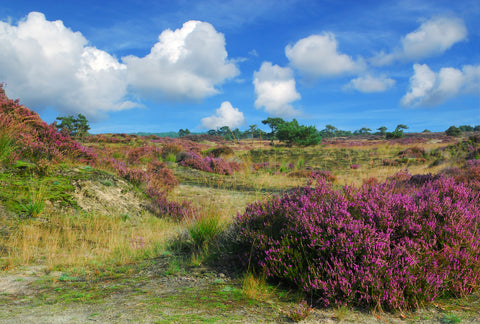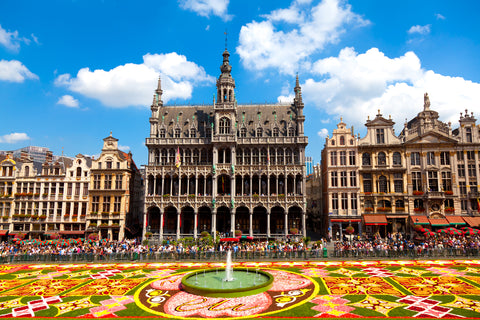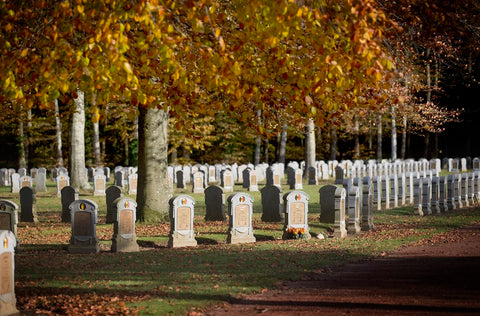- No products in the cart.
Battle of Waterloo

The late 18th century was a period of massive political upheaval. For centuries France had been ruled by an absolute monarchy supported by a powerful Catholic church, but in 1789 all this suddenly collapsed.
Feudal, aristocratic and religious privileges evaporated under a sustained attack from radical new political groups representing the previously unheard masses in the streets and peasants in the field.
Old and well-established ideas about tradition and hierarchy which had helped to prop up the monarchy.
The aristocracy and religious authority were all swept aside by the new principles of equality, citizenship and the rights of man. From the end of the 18th century, up until the first decade and-a-half of the 19th century, Europe's history would be coloured by one man, Napoleon Bonaparte.
Napoleon’s Rise

In 1792 a series of wars between the new revolutionary government of France and the established European monarchies began. The French won a spectacular series of victories and ended up controlling most of Europe. Much of this success was due to the efforts of Napoleon Bonaparte.
Napoleon was born in Corsica in 1769 and at the age of eight he was sent to the French mainland to study at the Royal Military School in Brienne.
In 1784 he spent a year at the Ecole Militaire in Paris, graduating as a Second Lieutenant of artillery.
During the Revolutionary Wars he fought effectively for the Republic, helping to beat the British forces at Toulon in 1793. As a result, he was promoted to the rank of Brigadier General.
This promotion was just the first step in what would eventually become a remarkable and impressive career, catapulting the feisty Corsican all the way to the top. Being Brigadier General was simply not enough for the ambitious Napoleon, so after a successful 'coup d'état' in 1799, he installed himself as First Consul, followed by crowning himself Emperor of France in 1804.
Without doubt, Napoleon is still considered as being one of history's greatest military commanders and most influential political leaders.
Flemish Suppression

When the French invaded, the historic Catholic University of Leuven was shut down (the Revolution was militantly anti-clerical and many churches were plundered too) and the economy cripples. Antwerp’s port was stopped from exporting goods and while the new heavy taxes had to be paid in gold or silver goods bought by the French were paid for with worthless paper assignats.
The region now known as Belgium was being bled dry and around 800,000 people fled abroad. Under the motto “One Nation – one language”, Dutch was suppressed across the country and French became the only acceptable language in public life as well as in economic, political and social affairs.
Continued repression, particularly a massive conscription to the French army in 1798, led to the Peasants’ War, which is often seen as the beginning of the modern Flemish movement.
This suppression continued until 1814, by which time much of Europe was ruled by Napoleon or members of his family. However, after a series of military setbacks, the Allies finally forced Napoleon to abdicate and he was sent into exile in Elba. French control of Belgium ended. But Napoleon escaped his island prison and was soon back in power in 1815.
The March To Waterloo

Napoleon knew that his only chance of hanging on to his imperial throne was to fight the Allied forces in what is now Belgium before reinforcements could arrive allowing his enemies to launch an attack on France. He crossed into Belgium with two armies on 16th June 1815.
One successfully attacked the Prussians under General Gebhard Leberecht von Blücher at the Battle of Ligny, while on the same day Marshal Ney was equally successful in his engagement with the forces of the Duke of Wellington and the Prince of Orange at the Battle of Quatre Bras.
Wellington’s army was pursued in the direction of Brussels, but two days later, Napoleon fought his final battle, at Waterloo, about 13 km south of the city of Brussels.
Wellington positioned himself cleverly on the Mont-Saint-Jean escarpment, a long ridge running roughly east west on either side of the main road from Brussels to Charleroi. A sunken lane ran along the crest of the ridge and there was a large elm tree that served as Wellington’s command post for much of the day. The length of the front of the battlefield was only about 4 kilometres (2½ mi). This allowed Wellington to position his forces in the centre and on the right, leaving the left to be covered by the Prussian army, who were expected to arrive later in the day.
Wellington’s position really presented a formidable challenge to any attacker, even to one as experienced as Napoleon Bonaparte.
The French were formed up on another ridge to the south and lacked the strategic benefits Wellington secured for him and his army.
Wellington, also known as the 'Iron Duke' or Lord Arthur Wellesley, became an infamous commander due to his unique and adaptive style of waging war against numerically far larger armies, while limiting his own losses to a bare minimum at the same time. Later in life he grew so popular he became British Prime Minister, twice. Today Wellington's strategic genius is still celebrated at the Wellington Museum in Waterloo.
French Arrogance?

Since he couldn’t see all of Wellington’s troops, Napoleon drew his forces symmetrically about the Brussels road. On the right were 16,000 infantry with 1,500 cavalry and a further 4,700 cavalry in reserve. On the left were a further 13,000 infantry and 1,300 cavalry with cavalry reserves of 4,600.
To the south were further reserves including Lobau’s VI Corps with 6,000 men, plus 13,000 infantry of the Imperial Guard and a further cavalry reserve of 2,000.
As he ate his breakfast off a silver plate in the house where had spent the night Napoleon told his chief of staff that just because Wellington had been successful in the past, this did certainly not make him a good general.
Wellington, he went on, was a bad general and the English bad troops and that winning the coming battle would be nothing more than eating breakfast. Little did Napoleon realise that this battle would become his final act as a military commander and he would see his own dismise being facilitated by this 'bad' English general the very same day. There had been heavy rain during the night and Napoleon knew that the sodden ground would limit the manoeuvrability of his cavalry and artillery, so he delayed his attack to allow the ground to dry out.
The Battle

It’s not clear when the battle actually began. According to Wellington it was “about ten o’clock”, but other sources put the starting time closer to 11.30 am. However, once the fighting did begin it was fierce and the battle lasted for most of the rest of the day. The infantry would form up in squares which the opposing cavalry charged.
If the infantry kept their cool and stayed in formation, it was virtually impossible for the cavalry to do anything other than ride away and try again. The role of the artillery was to try to stop the cavalry with accurate fire.
One eyewitness described how: “...the discharge of every gun was followed by the fall of men and horses like that of grass before a mower’s scythe”.
Eventually it became clear to the French that the cavalry on their own were achieving very little.
They then mounted a combined attack of about 6,500 infantrymen with as many of their horsemen that remained in a fit enough state to fight. Although the English Household Brigade cavalry halted the assault, it sustained heavy losses as a result of French musket fire. Napoleon then moved his horse artillery up towards Wellington’s centre and began to pulverise the infantry squares at short range – the British troops were mowed down where they stood rigidly in formation.
Fortunately for Wellington, Blücher’s Prussian troops arrived in the nick of time, but fierce fighting continued until nightfall.
Napoleon held out until it was clear that all was lost and the four remaining squares of the Imperial Guard covered his retreat. These brave grenadiers literally sacrificed their lives protecting Napoleon as they we're simply overrun and massacred by their opponents. Almost none of these men made it out of the battle alive. As Wellington later acknowledged: “It had been a close-run thing".
Aftermath

The French artillery and just about everything else they had brought with them fell into the hands of the Allies, including Napoleon’s carriage still containing his diamonds. These would later become part of the crown jewels of King Friedrich Wilhelm of Prussia.
Casualties on both sides were fearful. Wellington was left with around 15,000 dead or wounded and Blücher lost a further 7,000 men.
Napoleon lost about 25,000 killed or wounded, with a further 8,000 taken prisoner. When he visited the battlefield on 22nd June, four days after the battle, Major W E Frye found the scene to be “too horrible to behold”.
He described a multitude of carcasses and heaps of wounded men with mangled limbs, unable to move and perishing either from hunger, thirst or their untreated wounds.
The Battle of Waterloo was by no means the first and certainly not the last major battle to be fought on Belgian soil. But as has usually been the case, the main players were not Belgian, but came to fight and die there from a host of other nations. This battle’s place in history is assured because it finally put paid to the military career of a very remarkable man.
Out With The Old, In With The New...

After his defeat, Napoleon was exiled for a second time, on this occasion to St Helena. He died in 1821 at the age of 52 from a stomach illness that was originally thought to have been liver disease or cancer, but it is now thought likely that he died of arsenic poisoning.
On the positive side, the Battle of Waterloo and its aftermath ushered in a period of European peace that lasted for nearly half a century, with no further major conflict until the outbreak of the Crimean War in 1854.
After the war came the settlement. At the Congress of Vienna it was decided that the former Austrian Netherlands and the former Dutch Republic would be reunited to form the United Kingdom of the Netherlands as a buffer state against future French expansionism.
This new state was to be ruled by the infamous Protestant King William I of Orange. This was purely for political reasons and no consideration was given to the wishes of the people who were living there.
Sure enough, within fifteen years, a Revolution finally gave the regions now known as Belgium its independence, but that is a completely different story you can read about on our History page.
Commemorating The Fallen
A cluster of monuments mark the mass graves of the Allied troops and a monument to the French dead, L’aigle Blessé (The Wounded Eagle) is said to mark the spot where one of the Imperial Guard units formed its square during the closing stages of the battle. Today the battlefield is easy to find, just look for the giant mound of earth surmounted by a statue of a lion.
This Lion’s Hillock as it is known, was constructed on the order of King William I of the Netherlands to commemorate the spot where his son, the future William II and then Prince of Orange, was wounded after being hit by a musket ball.
The Prince was commander of the combined Dutch forces at both the Battle of Quatre Bras and Waterloo. The Hillock, completed in 1826, was constructed using a massive 300,000 cubic metres of earth taken from the ridge at the centre of the British defensive position.
Although Wellington later complained that the mound had destroyed his field of battle, much of the terrain and the buildings to the east of the Brussels-Charleroi road are very much as they were nearly 200 years ago. More information concerning the Battle's memorials in Waterloo can be found on our War Memorials and Cemeteries page.





